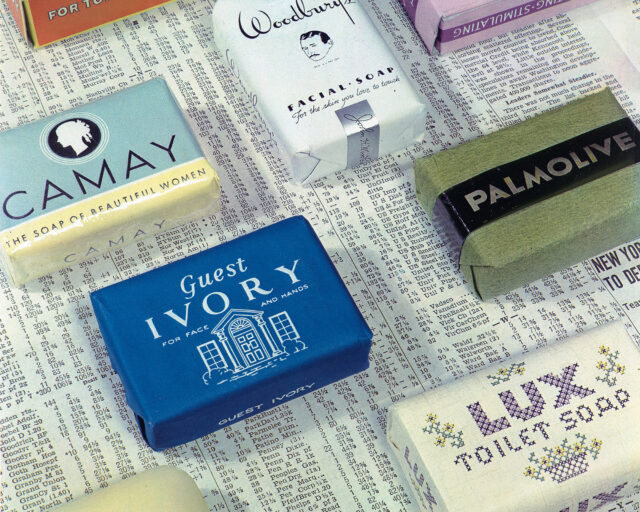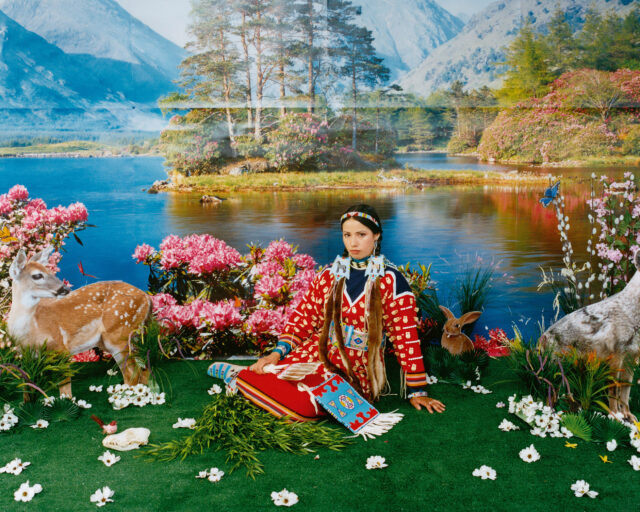5 Exhibitions to See in May
From teenage portraits to postwar Manhattan, here are must-see photography exhibitions in New York.

Sara Cwynar, Tracy (One Hundred Consecutive Years), 2017
© the artist and courtesy Foxy Production, New York
Foxy Production, 2 East Broadway #200, New York
Through May 14, 2017
In the past few years, colors described as “Millennial Pink” and “Rose Gold,” hues ranging from bubblegum to salmon, have become increasingly ubiquitous—and ambiguous. In Rose Gold, Sara Cwynar presents an investigation of this color’s propensity to seduce even those who are aware of its capitalist ploy. Her 16mm film Rose Gold (2017) traces the relationships of color, value, consumerism, and permanence, or lack thereof. “I love the rose gold iPhone,” say the voices of a male and female narrators in unison. Photographic portraits of Cwynar’s friend, Tracy, draped over deeply saturated fabric or gridded backdrops reminiscent of 1960s studio photography, present a response to the film’s examination of the aura surrounding rose gold and countless other color trends. Four of these feature superimposed found objects—perfume bottles, nude pantyhose, a golf ball—as well as vernacular and advertising images and fragments of text collected by Cwynar. Together, the works trace the decline of possessions from an object of desire to outdated kitsch, and expose the ephemerality of commercial-driven desire.

Eva O’Leary, Millie, 2017
Courtesy the artist and Crush Curatorial, New York
Crush Curatorial, 526 West 26th Street, New York
Through May 13, 2017
Though many people still recall a time before Facebook, we are already seeing the effects of social media on generations who can’t remember life without it. How does this constant connectivity, with its side effect of negative self-esteem, affect adolescents, an age group burdened with social pressure and uncertainty? Eva O’Leary seeks to answer this question by transforming selfies into formal portraits with a twist. O’Leary set up her 8-by-10 inch camera behind a large, two-way mirror. In her central Pennsylvania hometown, she invited girls ages eleven to fourteen to sit on the other side of the mirror, in which they could see only their reflection. The images project both self-assurance and unease. O’Leary pairs her poster-size portraits with a three-channel video that reveals the girls’ fixing, fussing, shifting, and styling. Unifying the portraits is a background of lapis lazuli, a shade of blue valued since ancient times and often used to represent wealth, signaling the timeworn practice of teaching girls that value is based on appearance.

Todd Webb, 125th Street, Harlem, New York, 1946
Courtesy the Museum of the City of New York and the Todd Webb Estate
A City Seen: Todd Webb’s Postwar New York, 1945–1960
Museum of the City of New York, 1220 Fifth Ave, New York
Through September 4, 2017
In 1937, when he traveled to Panama to visit a friend and prospect for gold, Todd Webb encountered the real treasure of his life: his passion for photography. For the next five years, photography became all-consuming. Webb studied at the Chrysler Camera Club in Detroit, where he met Harry Callahan and took a workshop with Ansel Adams. While in New York on his way to serve in World War II, Webb had a chance encounter with Alfred Stieglitz, who encouraged Webb to return to New York after the war. In 1945 he did exactly that, and continued photographing the city over the next fifteen years. The nearly 150 photographs on view at the Museum of the City of New York—which, in 1946, was the first institution to give Webb a solo show—depict a city bustling with industry and grateful to see the end of the war. Two trends emerge: Webb’s fascination with storefronts and signs, both advertisements and those welcoming home the G.I.s, and his attraction to the city’s architecture, towering over him from below, as well as in cityscapes made from the top of the Empire State Building.
![Walead Beshty, Cross-Contaminated Inverted RA4 Contact Print [Black Curl (CYM/Six Magnet/Six Magnet: Los Angeles, California, April 7, 2016, Fujicolor Crystal Archive Super Type C, Em. No. 112-006, Kodak Ektacolor RA Bleach-Fix and Replenisher, 06816), Kreonite KM IV 5225 RA4 Color Processor, Ser. No. 00092174], 2017 Courtesy the artist and Petzel Gallery, New York](https://aperture.org/wp-content/uploads/2017/05/WB-16_023L.jpg)
Walead Beshty, Cross-Contaminated Inverted RA4 Contact Print [Black Curl (CYM/Six Magnet/Six Magnet: Los Angeles, California, April 7, 2016, Fujicolor Crystal Archive Super Type C, Em. No. 112-006, Kodak Ektacolor RA Bleach-Fix and Replenisher, 06816), Kreonite KM IV 5225 RA4 Color Processor, Ser. No. 00092174], 2017
Courtesy the artist and Petzel Gallery, New York
Petzel Gallery, 456 West 18th Street, New York
Through June 17, 2017
Throughout his career, Walead Beshty has described the unseen labor behind everyday transactions. For his series Office Work (2017), Beshty skewered office machines, such as a scanner and an iMac, and left them plugged in while the devices attempted to complete their duties in vain. At first glance, four prints hanging on the wall look like they could be the product of an error in a massive printer. In fact, they are giant photograms, folded in half to produce a klecksographic image. The combination of the corporeal and the chemical extends to the series of works in Body Prints (2017), which includes copper-clad glass etched with either the imprint of a body part—for example, a right zygomatic bone and attending soft tissues, a left lateral epicondyle—or a facsimile of a pharmacy prescription for various medications. In Open Source, Beshty demonstrates the tragedy of forced labor and the sinister side of artificial substances.

Cang Xin, To Add One Meter to an Unknown Mountain, 1995
Courtesy the artist and The Walther Collection
Body, Self, Society: Chinese Performance Photography of the 1990s
The Walther Collection, 526 West 26th Street, New York
Through August 19, 2017
In Fen-Ma Liuming Walks The Great Wall (1998), Chinese artist Ma Liuming walks nude along the Great Wall of China. The series, a composite, multi-frame photograph and video documentation, expresses a delicate act of defiance atop a symbol of state power. The combination of body and landscape also appears in Cang Xin’s To Add One Meter to an Unknown Mountain (1995), in which ten artists stripped down and stacked themselves on top of each other; their amalgamated, sculptural form echoes the mountains receding into the misty background. Both works are central to Body, Self, Society, the second iteration of The Walther Collection’s yearlong series on Asian photography and video, which delivers a potent primer on Chinese performance art in the 1990s, a moment of radical experimentation in advance of the market forces that would eventually transform the lives and works of a generation of Chinese artists from the mid-2000s onward. Because of the lack of institutional support, as well as the omnipresent threat of government censorship, these performances were experienced only by small, trusted audiences. The camera, the only witness to the events, became both a stand-in for viewers and the artists’ sole connection to the broader art world.

























